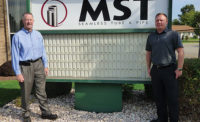Service Metal evolves in a volatile PVF marketplace
Industrial PVF master distributor Service Metal accepts the challenge.

CEO Christina Williamson (right) and her husband, Vice President Tim Williamson, are part of the executive management team for St. Louis-based industrial PVF master distributor Service Metal, which also has locations in in Charlotte, N.C., and Houston. Photo by Mike Miazga/Supply House Times

Executive General Manager Jim Fears (left) and National Sales Manager Ken Gebhardt combined have more than 50 years of experience with Service Metal. Gebhardt is based out of the company’s Charlotte branch, which opened in 1981. Photo by Mike Miazga/Supply House Times

Kevin Hyman is the branch manager of the Service Metal location in Sugar Land, Texas. The location has grown so rapidly that a move to a larger facility on the northeast side of Houston is scheduled for later this year. Photo courtesy of Service Metal.y was

Service Metal’s Charlotte location features sales staff members, from left: Laura Lagraba, John Curbeam and Tamaura Adair. Tim Wiliamson says the company Is able to move forward in a down market by being service-driven and offering competitive pricing. Photo courtesy of Service Metal.




They say the true measure of a company isn’t when things are going well during prosperous times, rather it’s when conditions are at their toughest.
And as those ingrained in the industrial pipe, valves and fittings arena know all too well, the last year or so has presented a less than rosy picture as the volatility of the oil and gas patch has produced some trying times in the supply chain.
Industrial PVF master distributor Service Metal has been affected by the oil-and-gas-downturn, but the St. Louis-based company is ready to meet the challenge head on.
Service Metal has dug in and is focused on finding ways to help the company move forward through an emphasis on customer service, its product lines and expansion. As a master distributor of industrial valves, flanges and fittings, Service Metal sells exclusively to industrial supply houses and PHCP wholesale companies.
“The past year has been flat overall for us,” Service Metal Vice President Tim Williamson says sitting in the conference room of the company’s main headquarters, about a 10-minute drive from downtown St. Louis. “We consider it a big win relative to market conditions. We had an aggressive year that put us in a stronger place and solidified our market share. Even though revenue was relatively flat we put ourselves in a position to gain that market share.”
Gateway to success
John C. Seitz started Service Metal in 1954 as a valve refurbishing surplus machine shop. The leadership of the company eventually passed toBob Hammersmith, one of Seitz’s sons-in-law. Hammersmith still is the company president with day-to-day operations being handled by Williamson and his wife, Christina Williamson, the company’s CEO and Hammersmith’s daughter, as well as company veterans Jim Fears (executive general manager) and Ken Gebhardt (national sales manager).
The company has grown to 56 employees and also has locations in Charlotte, N.C. (where Gebhardt works out of) and suburban Houston. Gebhardt started with the company in May of 1981 and the Charlotte location opened later that winter. Fears joined Service Metal in 1995 about the same time the company started transitioning into the role of a master distributor.
“In 1995 we still were dabbling in surplus and reconditioning valves,” Fears notes. “When I came in we started to transition over to factory new products and eventually in a short period of time got rid of all the surplus and evolved into strictly factory new material with full traceability. At first we had limited lines with just weld fittings, flanges and cast steel valves. We’ve expanded over the years to add other valves, brass gates, globes and checks and even forged-steel fittings, malleable iron fittings and steel nipples. We’ve expanded the product line quite a bit.”
Gebhardt adds: “We wanted to be more of a one-stop shop for the master distribution industry. Anything in carbon we’ve always felt we could add value to the supply chain.”
Mirror images
When the company expanded to Charlotte in the early 1980s and the Houston Gulf Coast region in 2013, it did so to not only increase the company’s customer-service capabilities throughout key parts of the country, but to also make sure customers in those new markets are able to receive the same high level of care as they would receive in the original St. Louis location.
With that in mind, the Charlotte and Houston locations are designed to be mirror operational images of what occurs back at St. Louis headquarters. “We wanted to replicate what we have here in St. Louis so we can better service a larger swath of the country,” Fears says. “Each location is set up to operate just as if you were here in St. Louis.”
The Houston area location, which sits in 43,000 sq. ft. in the suburb of Sugar Land, has been a big success for Service Metal. The company’s beginnings in the oil-and-gas epicenter occurred when it purchased a six-figure inventory from a struggling local master distributor and took over a 10,000-sq.-ft. location. The company has since moved into the Sugar Land building, but already has outgrown it. Plans are in the works to move into a 143,000-sq.-ft. location on the northeast side of Houston by Interstate 610 in the third quarter of this year.
By the time the new Houston location opens, the three Service Metal locations will have moved a total of 10 times due to company growth. “We’ve been in Houston about 2 1/2 years and we’ve had good success there,” Williamson says. “What we bring to the table down there has served us well. We’re continuing to grow and will continue to expand our presence in that region.”
In the service business
While Service Metal is prideful of the wide array of industrial PVF products it has on hand, it’s even more focused on competing at the highest level possible in the customer service arena.
“Aside from products, we are completely driven by service,” Williamson stresses. “That’s how we compete. We are not the biggest firm in the industry. We do a great job with our customers by making sure they are exposed to the highest level of service possible. When a customer calls in, they will be helped by a person, never a recording. Whether that customer has a sales inquiry, needs a tracking number or a material test report, a person will answer the phone and get the customer the correct employee to handle the issue. We’re a service-driven company with competitive pricing in the market.
“I would even say we’re a boutique company because of our focus on providing a high level of service that customers might not always be accustomed to in our market. All the while we’re maintaining pricing competitive with much larger competitors.”
Along those same lines, Service Metal is laser-focused on making sure customers receive materials in a timely fashion. Gebhardt recited some past industry horror stories of drivers waiting two hours in pipe yards to receive materials.
“We want folks in and out of our locations in 10 to 15 minutes,” he says. “Most of us have the same products whether its valves, flanges or fittings. For us, we have it all under one roof as a one-stop-shop master distributor. We can compete against the big boys because we are extremely service oriented. Our goal always is to ship it today so the customer can have it tomorrow.”
Fears adds another layer of Service Metal’s commitment to service stems from its flexibility in dealing with the different ways customers do business in an always evolving technology space. Service Metal is in the process of further upgrading its website at www.servicemetal.net to be of even more value to its customers.
“Some of our customers don’t have computers and hand-write orders. Others we never talk to on the phone and deal with strictly through email,” Fears says. “We adapt to our customers’ needs.”
Adaptability includes being ready to handle orders from small to large. “We will take a $1 order and we’ll take a $50,000 order. We’re set up for both,” Williamson says. “We’ll do whatever it takes to help our customers. Our customers are our survival. We are in the market to provide a memorable customer-service experience. That’s why we come into work every day.”
Service Metal executives also have a collective line on the pricing of its products. “We’re price driven and very conscious with how we go to market on that,” Gebhardt says. “We want our customers to get a good price and good value. If they are buying products from us we want our pricing to be competitive in the market.”
Other recent innovations focused on increasing customer service levels include the introduction of a comprehensive report that tracks order accuracy metrics, an advanced product location system in the company’s warehouses, as well as continued emphasis on machining (in the St. Louis location) and traceability.
“Our customers like that we can put MTRs with all the orders,” Fears says. “It’s a changing environment. Everybody wants traceability on everything and you have to make sure you can provide that.”
Williamson says the company also is planning on a product line expansion sometime in 2016.
The crystal ball
Service Metal executives always are monitoring the inner-workings of the industrial PVF supply chain where one constant challenge is the subject of imports. “The import landscape changes daily,” Williamson says. “Global demand has dropped and China has slowed down. Steel prices have dropped and the dollar has strengthened. We do our best to source products that better allow us to stay competitive in the marketplace. We’re constantly in communication and researching new mills so we can provide the best quality products and be able to stand behind what we sell.”
Gebhardt adds: “We make sure we’re using mills that are well-known in the master distribution marketplace.”
Williamson hears several conflicting forecasts concerning 2016 and the fortunes of the industrial PVF marketplace. Opinions aside, he stresses Service Metal is ready to come out swinging.
“Based on what you are hearing you hope for another flat year rather than a down year,” he says. “However it may turn out, we are going to adapt and compete. In a flat market we can still add customers and we are adding them. We’re going to develop customers like we’ve done in the past. We’re not stale and we don’t ever want to become stale. There’s still a lot going on in the midstream and downstream markets and a lot going on in some other industries. We’re a growth-minded company that carries inventory so our customers don’t have to. We’re here to win business.”
This article was originally titled “Challenge accepted” in the February print edition of Supply House Times.
Looking for a reprint of this article?
From high-res PDFs to custom plaques, order your copy today!












